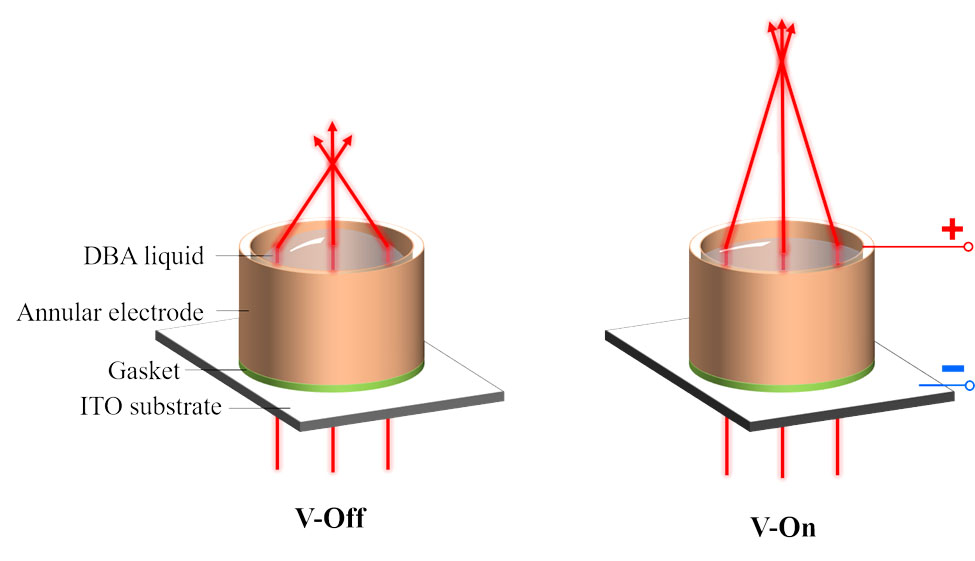| Jan 19, 2022 |
Researchers use electrically responsive fluid to make eye-like adaptive lens
(Nanowerk News) Researchers have developed an adaptive liquid lens based on a new electrically responsive fluid called dibutyl adipate (DBA) that changes focal length when a voltage is applied. The lens is lightweight, compact and simple to fabricate, which makes it ideal for mobile phone cameras, endoscopes, eyeglasses and machine vision applications.
|
|
“The human eye can arbitrarily focus on objects at different distances at incredibly fast speeds,” said research team leader Miao Xu from Hefei University of Technology in China. “Inspired by this functionality, we developed an eye-like adaptive liquid lens that can be used to diverge or converge light by changing the shape of the DBA liquid.”
|
 |
| Researchers developed an adaptive liquid lens based on a new electrically responsive fluid called dibutyl adipate (DBA). The new lens changes shape, and thus focal length, when a voltage is applied. (Image: Miao Xu, Hefei University of Technology)
|
|
In the Optica Publishing Group journal Optics Letters ("Variable-Focus Liquid Lens Based on Electrically Responsive Fluid"), the researchers describe their new DBA-based adaptive liquid lens, which weighs just a few grams, and show that it exhibits high optical performance with good stability. DBA’s electronegative molecular structure allows an applied voltage to be used to rapidly change the lens’ shape to modify its focal length. DBA is also transparent, non-volatile and inexpensive, making it ideal for use in adaptive liquid lenses.
|
|
“This type of adaptive liquid lens could one day replace conventional solid lens systems,” said Xu. “This would enable a mobile phone camera that can rapidly change focal length while still being as thin as the phone itself.” Because it doesn’t require any mechanical elements, this type of lens can be used for years without wearing out.
|
Turning liquid into a lens
|
|
The researchers created the new liquid lens by filling an electrode with DBA liquid, which forms a dome shape because the inner surface of the electrode is coated with a water-repelling layer. Applying a direct current causes the DBA molecules to accumulate at the anode, changing the dome shape in a way that is dependent on the voltage applied, thus changing the focal length. Removing the electric field causes the DBA liquid to recover its initial shape.
|
|
The DBA lens offers a significant improvement over adaptive liquid lenses based on electrowetting, which are available commercially. Electrowetting liquid lenses use a liquid, such as saltwater, which requires a dielectric film to separate the conductive liquid from the metal electrode.
|
|
“Our DBA liquid lens isn’t susceptible to volatilization or electrolysis, and because the DBA liquid directly contacts the electrode, there’s no need for an insulating layer,” said Xu. “This gives the DBA lens a simpler structure and better stability compared to an electrowetting liquid lens.”
|
 |
| The DBA liquid lens was made by filling an annular electrode with DBA liquid. The liquid forms a dome that changes shape when a direct current is applied. Removing the electric filed causes the DBA liquid to recover its initial shape. (Image: Miao Xu, Hefei University of Technology)
|
Demonstrating optical performance
|
|
Analysis of the new DBA-based liquid lenses showed that they exhibit an optical transmittance of around 95% at visible wavelengths between 390 and 780 nm and that performance remains stable at temperatures ranging from room temperature to over 200 °F. The researchers also demonstrated that increasing the applied voltage from 0 to 100 V changed the focal length from 7.5 mm to 13.1 mm and that the lens’ resolution can reach almost 29 lines per millimeter.
|
|
The researchers continue to work on making the new lenses more practical by developing ways to reduce the voltage needed to drive the DBA-based liquid lens, increase the resolution and improve the response speed to the order of milliseconds. They also want to reduce the effects of gravity on the DBA liquid so that larger lenses can be made.
|


